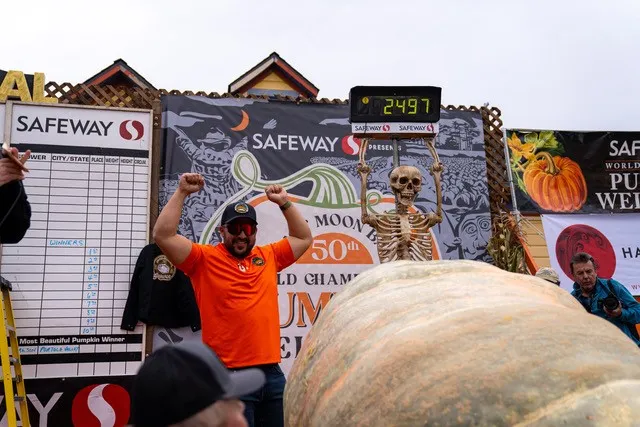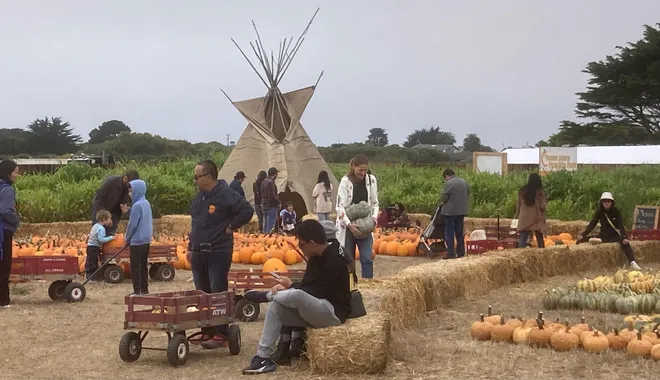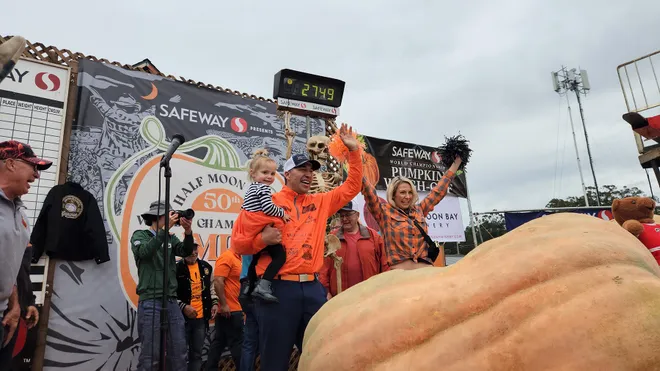'Pumpkins on steroids': California contest draws gourds the size of a Smart car
HALF MOON BAY, Calif. – Nick Kennedy is married with two kids under age 8 and a job as a project manager for a San Francisco tech firm, yet he spends countless hours growing enormous pumpkins for competitions, to the point of sometimes tending his patch until midnight.
“It’s definitely a full-time job,’’ says Kennedy, 37. “It’s like raising a family.’’
That dedication paid off last year when Kennedy and his growing partner Ron Root set a California record with a 2,497-pound behemoth at the Half Moon Bay World Championship Pumpkin Weigh-Off, which returns Monday as the prelude to the town’s popular art and pumpkin festival.
The contest, one of dozens across the U.S., is billed as the Super Bowl of such events and draws competitors from throughout the West Coast states, partly because of the industry-leading prize money offered by title sponsor Safeway supermarkets: $9 per pound for the winning gourd or $30,000 for a world record. Kennedy and Root collected $4,000 in finishing second last year.
But is that what drives grown-ups to forsake other activities and pour their efforts into cross-pollinating, feeding and nurturing great pumpkins of sizes Charlie Brown and the Peanuts gang could never imagine?
Far from it, say the growers, even if award-winning pumpkins can fetch up to $2 a pound in post-contest sales, typically to hotels or state and county fairs that may want to display them as fall attractions.
“This is a very expensive hobby,’’ said Root, the 2010 champion at Half Moon Bay. “It’s thousands upon thousands we put into our patch every year, so everything we can recoup, it helps. But I don’t do this for profit. If I tried to do it for profit, I’d lose money nine times out of 10.’’

Pumpkin growing partners score with 'Pohaku'
Root, 64, said he took up pumpkin growing years ago as a way to get outdoors after a workplace injury forced him to retire from his job with the Sacramento County Sheriff’s Office. He was no longer entering contests when Kennedy sought him out in 2021, looking for a mentor to teach him how to develop a pumpkin patch to share with his son, now 7.
Neither grows commercially, but they were raised in gardening families and had a passion for the activity. They soon combined Root’s vast expertise with Kennedy’s knowledge of data and technology, which they apply to variables such as ground moisture, nutrients, shade percentage and soil and tissue levels.
“I often compare giant-pumpkin growing to bodybuilding, because these things look like pumpkins on steroids,’’ Kennedy said.
The partners take only December off in growing four pumpkins a year at their patch in Sacramento County, where the gourds may put on 60-70 pounds a day.
It was easy for Root and Kennedy to tell early on they had something special in last year’s entry at Half Moon Bay, which stood out just like the youngest of four brothers who grows much taller than the rest. Kennedy compared its size – 7 feet by 6½ feet and about 45 inches tall – to a Smart car, which can measure as little as 8½ feet by 5½ feet and 61 inches in height.
They named the pumpkin Pohaku – Hawaiian for a stone or rock – and it broke the state record by nearly 200 pounds, coming in second behind the world-record-setting 2,749-pound monster brought in by three-time champion Travis Gienger of Minnesota.
Root said he later saw dozens of photos online taken by people who spotted them taking Pohaku to last year’s competition.
“You get so much enjoyment from it,’’ he said. “When you have a great big pumpkin and you’re driving it to the contest, the amount of people who are taking pictures or honking or waving at you, it’s just phenomenal.’’

Gourds and glory: Pursuit of pumpkin records dates to the 1800s
Jack La Rue, a former competitive grower who’s now a historian and statistician for the Great Pumpkin Commonwealth – the international ruling body for these contests – said the pursuit of record-setting pumpkins dates back to at least the late 1800s.
At the 1900 world’s fair in Paris, William Warnock set the recognized mark at 400 pounds, and topped it by three pounds in 1904. That record stood for 72 years until Bob Ford smashed it with a 451-pound gourd. In 1980, Canadian Howard Dill gave the movement a major push when he set one of his three world records with a 459-pound pumpkin the year after developing the Dill’s Atlantic Giant Pumpkin seeds.
The Half Moon Bay weigh-off had started in 1974, when the California town barely edged out Circleville, Ohio, in an amiable contest for the fictitious title of pumpkin capital of the world.
The competition from other sites has increasingly gotten tougher, but La Rue said he still ranks Half Moon Bay as the leading contest, kept aloft by hosting the current world mark set by Gienger.
“Right now, Half Moon Bay stands on top of the world for the heaviest 10 pumpkins (on average) ever weighed at one site,’’ La Rue said.
Half Moon Bay, a coastal town of 11,000 residents less than 30 miles south of San Francisco, comes alive every October in the weeks before Halloween.
The giant-pumpkin contest kicks off events on Columbus Day, and they’re capped by the weekend festival, which has put the town on the map. Now going into its 52nd edition, the festival draws tens of thousands of visitors, many of them eager to get their photos taken with the colossal pumpkins.

'Ginormous': Pumpkin fest attracts visitors from all over
Nicole Lopes and Brittanie Bretao, who help their husbands run the local Farmer John’s pumpkin patch, start to see the entries arrive by truck the Sunday before the competition and can’t help but marvel at their size.
“Oh, they’re ginormous,’’ Lopes said. “It’s amazing to see because it takes so much effort to grow them.’’
“They look so much bigger in person than when you see them on TV,’’ said Bretao, adding that while the festival leads to crowds and traffic that can be a hassle for the locals, it also creates a welcome buzz.
“Visitors from Europe and Australia come because they have heard of the festival, so they come for the pumpkins and the fall activities,’’ she said.
That’s good for business, said Bobby Marsh, whose namesake father started what’s now Bob’s Pumpkin Farm by selling the gourds by the side of a road as a youngster in the mid-1950s. At the time, the elder Marsh said, the only two pumpkin farmers in town just fed them to their animals. He saw a need to fill when people repeatedly asked to buy them for their own use.
“I was the most popular kid in school because I had money,’’ he said with a smile.
The pumpkin patches he helped start have evolved into an attraction that draws families from the surrounding areas seeking entertainment for their kids – be it taking hayrides, running around cornstalks or climbing hay bales – in addition to picking Halloween decorations for their homes.
“We really enjoy it. It’s a great atmosphere,’’ said Mark Lyubovitsky of Redwood City, visiting the Farmer John’s patch with his wife and pre-school kids for the third year. “We love Half Moon Bay in general. They do a wonderful job with the festival and they make it very lively and fun, very family-friendly. It’s obviously a beautiful backdrop of nature, super scenic.’’

'Have you grown a 2,500-pound pumpkin?'
The half-century-old weigh-off attracts growers from across the country and other parts of the world, but mainly as observers instead of competitors because of the difficulty of lugging the colossal pumpkins.
Gienger, who is aiming to set another world mark Monday, says folks in his hometown of Anoka, Minnesota, frequently ask why he would travel more than 2,000 miles and 35 driving hours to Half Moon Bay.
Besides the special treatment he gets from organizers, Gienger said he enjoys the challenge of improving on his previous performance, even though he would have incurred $5,000 in losses if he hadn’t won last year.
“You don’t put in a whole summer’s worth of work to not top your best,’’ Gienger said. “That’s kind of what keeps me going.’’
Gienger, 43, has been teaching horticulture at Anoka Technical College for 12 years and said he takes a different approach than other growers in how he feeds and waters his pumpkins. He grows only two a year in a 1-acre plot of land behind his house and picks his entry for the competition early on.
The interest in giant pumpkins developed early for Gienger, who said he grew one that weighed 447 pounds by the time he was 13 or 14. After all these years working the land, he would rather rely on his accumulated knowledge than any modern techniques.
“I know guys have soil moisture meters and this and that technology. I don’t do that as much as I probably should,’’ Gienger said. “I had one person try to tell me I need more nitrogen, which is great. But it’s like, have you grown a 2,500-pound pumpkin?’’
Disclaimer: The copyright of this article belongs to the original author. Reposting this article is solely for the purpose of information dissemination and does not constitute any investment advice. If there is any infringement, please contact us immediately. We will make corrections or deletions as necessary. Thank you.



